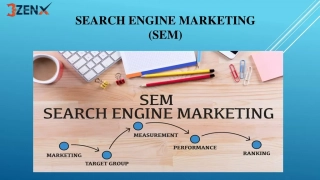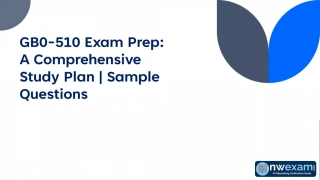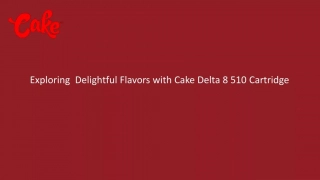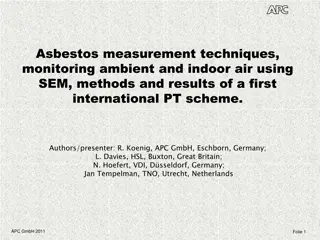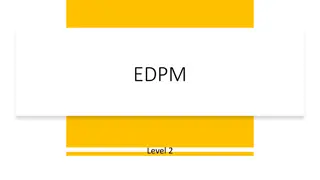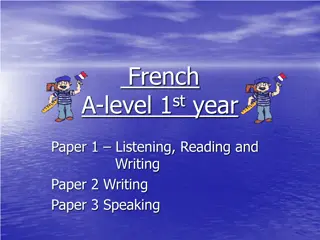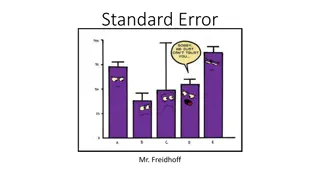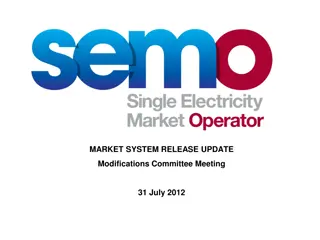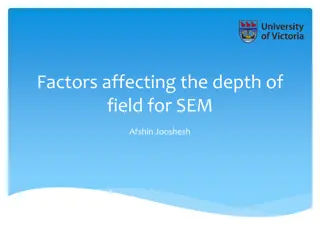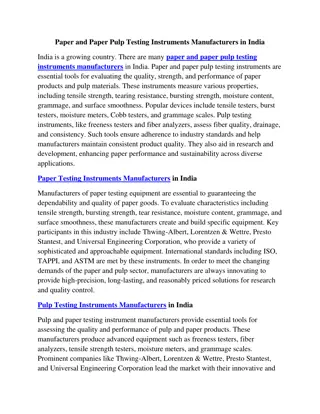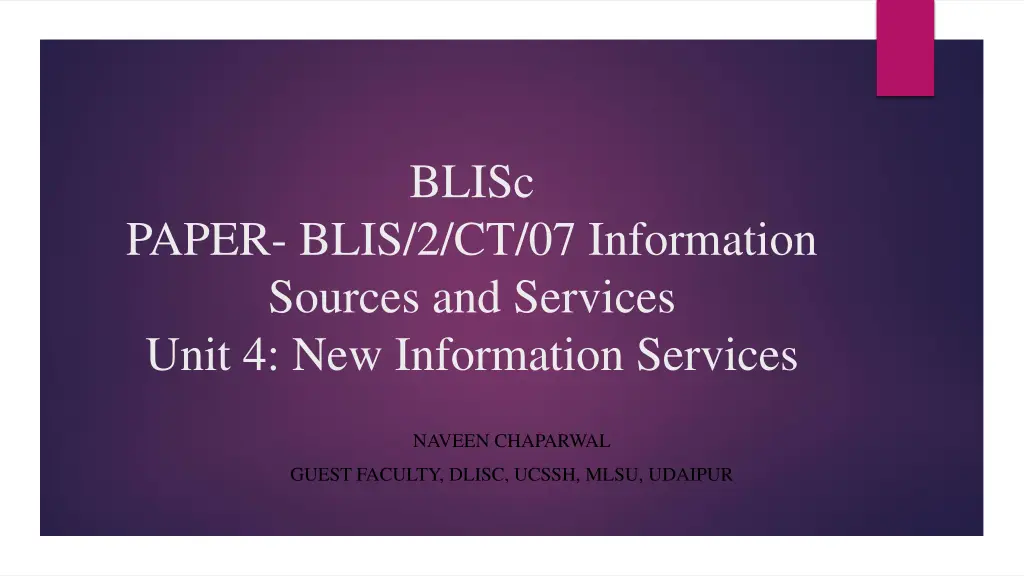
Databases in Libraries: An Overview of Information Services
Explore the world of databases in libraries, including bibliographic and full-text databases, their leasing agreements, and the variety of database services offered by different providers such as Chemical Abstracts Service. Learn about CAS databases covering chemistry literature, patents, chemical substances, and reactions.
Download Presentation

Please find below an Image/Link to download the presentation.
The content on the website is provided AS IS for your information and personal use only. It may not be sold, licensed, or shared on other websites without obtaining consent from the author. If you encounter any issues during the download, it is possible that the publisher has removed the file from their server.
You are allowed to download the files provided on this website for personal or commercial use, subject to the condition that they are used lawfully. All files are the property of their respective owners.
The content on the website is provided AS IS for your information and personal use only. It may not be sold, licensed, or shared on other websites without obtaining consent from the author.
E N D
Presentation Transcript
BLISc PAPER- BLIS/2/CT/07 Information Sources and Services Unit 4: New Information Services NAVEEN CHAPARWAL GUEST FACULTY, DLISC, UCSSH, MLSU, UDAIPUR
Database Services A database is a collection of related information stored in a computer so that it is available to many users for different purposes. The content of a database is obtained by combining data from different sources in an organisation, so that the relevant data are available to all users and redundant data can be eliminated or atleast minimized A database consists of one or more files. A file may consist of one or more records. A record may consist of one or more fields. A field may consist of one or more data elements. A data element may be made up of one or more character strings. The important thing is that a database allows you to store data and get it or modify it when you need it easily and efficiently, regardless of the amount of data being manipulated.
Most databases used in the libraries are bibliographic databases (such as catalogues, periodical indexes, abstracting services) and full-text databases (such as e-journals, reference sources). These databases are leased annually to the libraries under license agreement by the database producers. Database content is created by database producer, who usually publishes a print version and converts the content in machine-readable form to provide access to data on CD-ROM or online via Internet using propriety search software. The database producer provides online access to its databases through its own website or leases the content to one or more database vendors (such as EBSCO, ProQuest), who in turn provide access to these databases to registered library staff and users. Variety of database services is currently offered by primary and secondary journal publishers, online database vendors, aggregators, digital libraries, institutional repositories, search engines, etc. on the Internet. In subsequent sections you will study about these services.
CAS (Chemical Abstracts Service) Databases CAS a Division of American Chemical Society, indexes and abstracts world s chemistry related literature published in over 10,000 major scientific journals world over in 50 languages. It also covers patents and patents family references from 61 patents authorities around the world. CAS database contents can be accessed via SciFinder and STN on the Web. CAS offers range of products and services. The information products of CAS are: CAplus Database: Contains bibliographic information and abstracts for over 34 million records from 1800AD to present. Database is updated daily adding 3000 records per day. The web version allows searching the database by research topic, author name, company name, document identifier, journal, and patent. CASRegistry Database: This is a Factual database of chemical substances covering over 52 million chemical substances. Information covers structure of the chemical substance, molecular formula, predicted and experimental properties, and unique Registry number. Substance page allows searching substances by structure, molecular formula, and substance identifier. CASReactions Database: This is Factual database covering one step to multistep reactions of chemical substances.
Services offered by CAS: Links from references to electronic journals and patent documents. Provides links to cited references dating back to the late 19th century. Links are provided to over 280 STM (Science, Technology and Medicine) publishers for full-text journals. Links to full-text of patents from 2 major patent offices are offered. Common Chemistry: Afree web resource that contains CAS Registry number for approximately 7,900 chemicals of wide spread public interest. CAS had collaborated with Wikipedia to develop this resource. Other fee-based services are CAS Client Services like confirmation, identification or assignment of CAS Registry number and document delivery service. CAS Media Library: Covers current interest topics and new discoveries and shows how SciFinder and STN can play a significant role in providing solution for the advancement of science. Provides step-bystep instructions online using multimedia presentation. SciFinder is a software tool that helps to search CAS databases containing many scientific disciplines including biomedical sciences, chemistry, engineering, material sciences, agricultural sciences, etc. SciFinder finds references to biomedical research using CAplus and MEDLINE databases and allows searching protein and nucleic acid sequences from biomedical patents and journals. (http://www.cas.org/)
MEDLINE/PubMed Database MEDLINE (Medical Literature Analysis and Retrieval System Online) is a premier bibliographic database of the U.S. National Library of Medicine (NLM). MEDLINE contains over 21 million references to journal articles in life sciences with concentration on biomedicine. The database covers approximately 5200 journals world wide in 37 languages. The database is updated daily adding 2000 to 4000 records everyday. The records are indexed using controlled vocabulary from NLM s Medical Subject Headings (MESH). MEDLINE is the primary component of PubMed database (http://www.nlm.nih.gov/) searchable via Entrez. MEDLINE/PubMed may also be searched using NLM Gateway (http:// gateway.nml.gov/), a service from the National Institute of Health. PubMed Central (PMC): This is full-text database from U.S. National Institute of Health (NIH).The database consists of full- text articles (over 1,500,000) from 450 journals, that are linked to PubMed and are fully searchable free of charge. National Library of Medicine has over 100 databases created by NLM international partners and collaborating agencies. All these databases are searchable online. Some of them are as follows: MedlinePlus: Health information for patients, families and health care providers. AIDSInfo: Database ofAIDS Clinical trials. BookShelf: Collection of online biomedical books whose full-text can be searched through Entrez system. ChemIDPlus: Online dictionary of chemicals including names, synonyms, and chemical structures.
3D Domain: Macromolecular structural database. GenBank: Genetic sequences databases. Protein: Protein sequences databases. Nucleotide: Nucleotide sequence databases. MESH Database: Online database of Medical Subject Headings. MESH Browser: Medical Subject Headings look up tool. NLM Catalog: Online public access catalogue of NLM. OLDMEDLINE Data: References to biomedical journals articles through 1948 to 1965. TOXLINE: Database of 4 million references to toxicological literature. TOXNET: Toxicological data networks. Database on toxicology, hazardous chemicals, and environmental health. PubMed services cover the following: Journal databases: search by topic, journal title, or abbreviation, ISSN, or browse by subject terms. Limit searches to PubMed journal or currently indexed MEDLINE journals. Clinical queries: Asearch interface for finding citations to specific clinical study category; systematic reviews or medical genetics. MEDLINE/PubMed databases are searchable via Entrez. Entrez is a search engine run by National Center for Biotechnology Information (NCBI), which is a part of NLM, under the guidance of the National Institute of Health (NIH). MEDLINE/PubMed may also be searched using NLM Gateway (http://gateway.nml.gov/), a service of the National Institute of Health. PubMed database can be searched free of charge. Citation may include links to full-text articles from PubMed Central or from publishers website.
ScienceDirect ScienceDirect (http://www.sciencedirect.com): Elsevier, world s leading publisher of science and health information (http://www.elseveir.com/), publishes over 2380 primary scholarly journals in print as well in electronic form. The publisher offers online searching of over 2500 e-journals, 26 bibliographical databases, and 20,379 books in science and technology. Elsevier provides access to full-text e-journals and book chapters via ScienceDirect. ScienceDirect is full-text database offering online access to articles from more than 2500 peer-reviewed e-journals and chapters from more than 11,000 books in science and technology. At present there are more than 9.5 million articles/ chapters in the database. The database is growing at a rate of 0.5 million items per year. The e-journals are searchable from year 1995 onwards. Journal s contents are available for search even at an early publication stage. Search options allow downloading, saving and printing of multiple documents. Search results can be forwarded to other researchers when desired. Elsevier publisher offers a variety of subscription and access options to the subscribers such as ScienceDirect Complete, ScienceDirect Standard, and ScienceDirect e-Select. Depending upon the type of library or information centre, different editions of ScienceDirect are available such as ScienceDirect Government Edition; Corporate Edition; College Edition; and Business School Edition.
Variety of database services are offered to the subscribers such as: Science Alert: Runs a saved search automatically and delivers an e-mail notification with link to the new search results. Journal IssueAlert: Send an e-mail notification when a new issue of a specific journal is made available on ScienceDirect. Citation Alert: Send an e-mail notification when a document which cites a specific article of interest is added to ScienceDirect. Topic Alerts: Notifies the subscribers by e-mail when a predefined topic related search retrieves new results. ScienceDirect Top 25 Hottest Articles : An e-mail sent every 3 months to subscribers, listing 25 most frequently downloaded journal articles from any selected journal among more than 2,000 titles. Specific Journal Alerts: Some groups of journals have specific alerting services. Apart from above listed services Elsevier offers online training, customised settings, and usage reports for subscribing libraries. SCOPUS: (http://www.scopus.com): The largest abstract and citation database of peer-reviewed journals and web resources. Updated daily, Scopus offers nearly 18.000 titles from over 5,000 international publishers, including peer-reviewed journals (16,000), open access journals (1200), trade publications (600) and bookseries (350). The database offers full integration of the Scientific Web in its search results with 435 million web pages. It also provides access to 23 million patents from 5 patent offices, articles-in-press from over 3000 journals, and sources from institutional repositories, digital archives, etc.
Aggregators E-journal publishers, in addition to providing full-text access to their publications from their own websites, are also making their e-resources available through vendors and other third party mediators for exploitation under license agreement. Third party mediators, known as aggregators provide online access to a large number of journals from different publishers on a single platform and customise information for individual libraries based on the needs of each library. This type of arrangement is beneficial for both the libraries and the publisher. Libraries can enter into agreement with single service provider instead of dealing large number of publishers. Publishers gain increased exposure for their services by making their contents available through more than one source. There are large numbers of aggregators providing e-journal services on the Internet. Some of them are EBSCO, ProQuest, J-Gate, etc.
EBSCO: EBSCO Industries Inc. is a global corporation with divisions in 23 countries around the world. EBSCO Industries have diversified into 40 businesses, including, electronic and print periodical subscription services, research databases and related information management services. EBSCO provides integrated services, that combines reference databases, subscription management, online journals, books linking services, and A to Z solutions. (http://www.ebsco.com/) J-Gate (http://j-gate.informindia.co.in/): J-gate is an electronic gateway to global e-journal literature. Launched in 2001 by Informatics India Ltd., Jgate provides access to over 5 million articles of e-journals online. It has database indexed from 25940 plus e-journals with links to full-text articles at publishers site. It indexes articles from 9400 open access journals and maintains links to them.
Translation Services and Machine Translation Research in India We may define translation as the act of presenting a text in a language, other than the one in which- it was originally written. This may appear to be a definition which is good enough. However, it is not. It is quite possible, and sometimes it happens, that you translate a text, rendering it into another language but you fail to put across the message contained in the original text. Translation is an act of presenting a text in .a language other than the one in which it was originally written, in order to convey the meaning of the original text.
Machine translation Machine translation (MT) is the application of computers to the task of translating texts from one natural language to another. In MT system, the computer program analyses the text in one language-the source text and then produces another equivalent text in another language-the target text - without human intervention. The translation process, as discussed earlier, involves de-coding the meaning of source text and re-encoding the meaning in target text . However, behind this simple procedure there lies complex cognitive operation. For instance, to de- code the meaning of the text in its entirety, the translator must interpret and analyse all the features of the text, a process that requires in depth knowledge of both, the grammer, semantics, syntax, idioms of the source language as well as the culture of its speakers. The translator needs the same in depth knowledge to re-encode the meaning in the target language. Therein lies the challenge in MT system, how to program the computer to understand a text as a human being does and also to create a new text in the target language that sounds as if it has been written by a human. This problem has been tackled in number of ways. Generally the rule-based methods (such as lexical lookup method, grammer based methods, and meaning based methods), which parse a text, creating an intermediary, symbolic representation, from which the text in target language is generated, have been found successful in machine translation. However, these methods require extensive lexicons with morphologic, syntactic, and semantic information, and large set of rules.
Machine Translation Research in India India is a linguistically rich country with 24 official languages, each of which is spoken by millions of people in the country. Since most of the information is generated in English and English and Hindi constitute bulk of correspondence in government offices, these languages have been identified as priority area of research in machine aided translation in India. Accordingly, two specific areas of research have been identified: i) MT systems for translation between Indian languages, and ii) MT systems for translation between English to Hindi. Realising the immense potential of MT, Department of Official Language (DOL), Government of India, began actively funding projects in MT research. Currently, institutions in the country namely C-DAC, Mumbai and Bengarulu and IITs have taken the lead in developing MT systems. Ministry of Information Technology has identified the following domains for the development of domain specific translation systems: i) Government administrative procedures and formats; ii) Parliamentary questions and answers; iii) Pharmaceutical information; and iv) Legal terminology and judgments.
C-DAC (Centre for Development of Advanced Computing) Mumbai and Bengaluru (erstwhile National Centre for Software Technology (NCST) Mumbai) is a scientific society under the aegis of Department of Electronics and Information Technology. It is devoted to the research and development in the area of software technology. C-DAC has undertaken many projects and one of the projects in the area of machine translation is called E-ILMT (English to Indian Languages: Machine Translation System). The members under this project constitute IITs, (Hyderabad, Mumbai, Allahabad) state universities (Jadavpur, Utkal) IISc Bengaluru and C-DAC, Mumbai and Pune. The scope of the project E-LIMT is to develop and design machine translation system from English to Indian languages in the areas of tourism and health care. The main objective of the project is to remove language barriers in a country like India (http://www.cdacmumbai.in/index.php/cdacmumbai/) where there are 24 official languages. Department of Computer Science and Engineering of IIT, Kanpur has developed two machine translation systems for translating English text in Indian languages. These MT systems are ANGLABHARTI and ANUBHARTI. ANGLABHARTI system is based on pattern directed approach. This means that different patterns of source language are examined and stored in the system. Most of the translation job is done by the machine on the basis of the patterns stored in the system. Only 10 per cent work is done by human intervention in the form of post editing work. ANUBHARTI system of MT is based on example- based approach. This approach needs a database of examples for translation work. (http://www.iitk.ac.in)
Anusaarka is a machine translation system developed by Chinmaya International Foundation, IIT Hyderabad and University of Hyderabad, Department of Sanskrit Studies. Anusaarka is a Sanskrit word which means to follow. It is an English Hindi language accessing software. This helps the users to have access to the translated text in any Indian language from the source language(s) i.e. English or any Indian regional language. (http://anusaarka.iiit.ac.in) The slow development of MT systems in India is due to lack of lexical resources for Indian languages. Indian groups are now addressing this challenge jointly by starting a collaborative open source initiative called LERIL (Lexical Resources for Indian Languages), which includes several groups such as IIIT Hyderabad, NCST (now C-DAC Mumbai), Mumbai, Kendriya Hindi Sansthan, etc. Sharing of resources would help MT projects to take off at a faster rate. In conclusion, it can be said that India has made significant progress in MT research. Currently, Ministry of Information Technology is sponsoring about 75% of the MT projects in India. The Technology Development for Indian Languages (TDIL) Programme was launched by Ministry of Information Technology, Govt. of India in the year 1991- 1992. The Programme aims at promotion and development of computerbased translation tools for Indian languages. (http://www.tdil.mit.gov.in/).
Translators Associations Indian Scientific Translators Association (ISTA) was established in 1962. Dedicated to the cause of promotion of scientific translation in India, the association has been making persistent efforts to bring S&T translation to the focus of public and government attention through talks, discussions, seminars, surveys, workshops, publications, etc. The main objectives of ISTAare to: promote facilities for scientific translation in India; endeavor to improve the status and service conditions of scientific translators; promote training facilities for scientific translation and take such measures as would lead to the maintenance of a high standard of scientific translation; convene conferences or conduct seminar on scientific translation; cooperate with national and international organisations with similar objectives; bring out publications which will tend to the realisation of the objectives of ISTA; and do all such activities as are incidental or conducive to the attainment of the objectives of ISTA. Since 1972, the association has been publishing JISTA, Journal of Indian Scientific Translators Association. Published annually, JISTA covers articles and news items on theoretical and practical aspects of translation, training of translators, linguistic issues, scientific terminology problems, machine translation, updates on science and technology, etc. The association celebrates International Translation Day on 30 September every year (since 1992).
E-PUBLISHING: Meaning and Kinds The first book produced by Gutenberg's printing press is the "Gutenberg 42- line Bible The generic term Electronic publishing or e-publishing is used to define the production of any that is published in digitized form. It uses new technology allowing publishers to deliver documents and other content quickly and efficiently as well. E-publishing is helpful in producing documents containing text, graphics, still or motion pictures, audio, video, tables, numeric, equations, or a combination of any or all of these with the assistance at a data processing system. Electronic Publishing can be defined as any process which uses information technology to deliver information products in electronic form to an audience. It may involve the production of printed material, but more particularly the creation of CD-ROM and online products and services (reference material, electronic journals, specialized databases) which may be distributed and used without ever appearing in printed form. It may be carried out as a primary commercial concern (e.g., producing newspapers, books and magazines) or as a vital component of other organized processes such as administration, research, education, and voluntary public service.
In other words, it is a computer aided or assisted process of publishing in which the documents are submitted in electronic form, edited, printed and even distributed to readers by employing computer and telecommunication networks; and the product of e-publishing may consist of abstracts, full texts, graphics, pictures, animations, sound, motion pictures and interactive features as well. Some scientists describe it as application of Information Technology to traditional print publishing and according to them the term electronic publishing refers more precisely to the storage and retrieval communications media. So e-publishing can be represented as the combination of Information Technology and traditional publishing techniques i.e., e-publishing = Information Technology (= Computer Technology + Communication technology) + Publishing Techniques. of digitized information through electronic The concept of epublishing covers a variety of publishing models and formats. E-publishing models include commercial e-publishing, subsidy e-publishing, distributors , and self e- publishing.
KINDS OF E-PUBLISHING PRODUCTS E- Books Electronic Journals E-zine Electronic Thesis and Dissertations E-reference Sources Other types of E-documents
References http://egyankosh.ac.in/bitstream/123456789/26259/1/Unit-1.pdf http://egyankosh.ac.in/bitstream/123456789/35338/5/Unit-10.pdf http://egyankosh.ac.in/bitstream/123456789/14110/1/Unit-1.pdf http://egyankosh.ac.in/bitstream/123456789/11123/1/Unit-12.pdf Tucker, Allen B. and Nirenburg, Sergei (1984). Machine Translation : A Contemporary View. Annual Review of Information Science and Technology. 19, 129-55. http://egyankosh.ac.in/bitstream/123456789/35912/5/Unit-10.pdf http://egyankosh.ac.in/bitstream/123456789/11199/1/Unit-10.pdf

